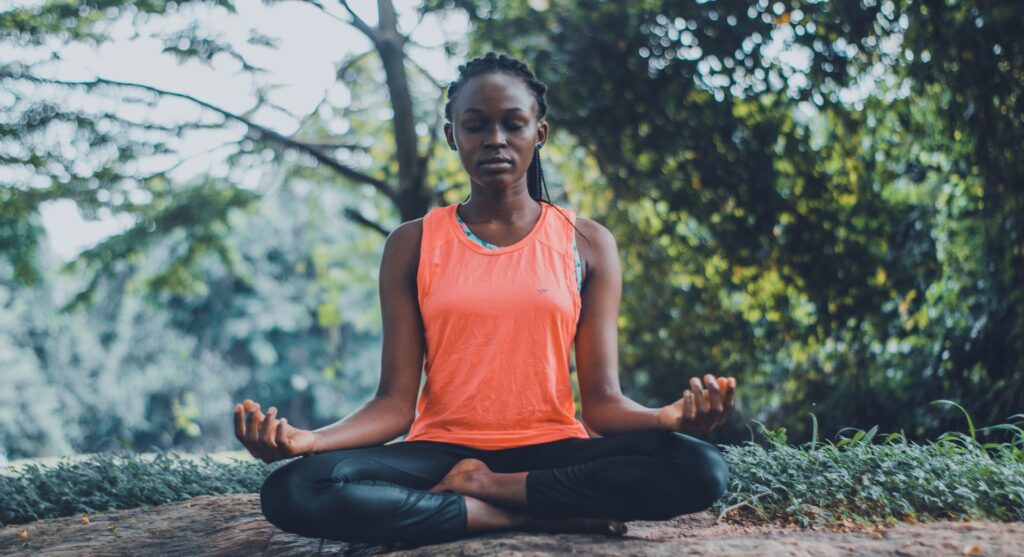“Read or sit in revelry and watch the changing colors of the waves that break upon the idle seashore of the mind.”
– Henry Wadsworth Longfellow
I read this quote this morning as I was engaging in my Sunday morning practice. Every Sunday, I wake up and spend some time reading from one of my inspirational quote books that I keep over my bed. They have a home up there along with several other spiritual texts that point the way into a well-lived life. Often, when you speak of meditation, people state things like, “I can’t meditate. How could someone ever sit there and do nothing for so long? I don’t really know what to do. I don’t get the point of it.” Today, I want to clarify a few of the 8 limbs of yoga in one shot because I feel they all very much fall into this practice of meditation, which is what yoga, at it’s core, is about.
Dhyana is the limb that speaks directly to contemplation and meditation. It is the practice whereby we sit in stillness with ourselves and listen. It is often said that prayer is when you speak to God, but meditation is where God speaks to you. Often, many say that the goal of meditation is to, “quiet the mind,” but for a beginner hearing this is fairly unhelpful because it’s almost as though you have been told not to think of a pink elephant. When you believe the goal is to “not think” your mind immediately does the opposite and then you get frustrated and annoyed that you can’t seem to make your mind stop thinking. Many meditation books will talk about the mind as a clear lake where you are trying to see down to the bottom. However, when thoughts (movements) arise they create ripples in the lake, which prevents you from clearly seeing what lies at the bottom.
I started a meditation practice well before I ever stepped onto my mat and began asana practice. I was desperate for some clarity and some peace, had heard some positive things about meditation and said, “Hell, I’ll try anything.” So I went on YouTube, looked up guided meditation, and laid on my bed in Savasana (corpse pose) listened to the guided meditations and tried to visualize the scenery they were asking me to visualize, relax the parts of my body that they were telling me to relax, and found that I felt this tingly, energetic, calming sensation flowing over my body… most often my hands, but throughout the rest of my body too. I became curious about the sensations I felt while meditating and began to think of these sensations as my “visits from Spirit.” I kept making time for meditation because I enjoyed the way I felt during and afterward. During, I liked the sensations of peace, I liked being able to feel sensations I had never really noticed before, and I enjoyed the “bliss bubble” I felt I was floating in after each session. It felt good and so I stayed with it.
While I started with guided meditations, in time I found myself preferring just music. Meditation music that allowed me to sit and be only with myself, without the intrusion of someone else telling my mind where to go or what to focus on. I was curious to see if there was a difference. I found that my mind would automatically start to focus around prayer. I would find myself guiding myself through the meditation imagining that I was breathing in love allowing it to consume me and breathing out everything in me that I wanted to be rid of… hurts and darker emotions mostly. I found that sitting with only music allowed me to get rid of the thoughts that “I wasn’t doing it right.” With the guided meditations, I felt frustrated at times when I couldn’t visualize some scene that they were asking me to or if I couldn’t see my “spirit animal” or some “spirit guide.” Yes, some of the meditations attempt to take you to meet some spiritual being and these never really worked for me. Probably because I’ve always relied on God alone and don’t necessarily believe that God has any image, but many images. Sitting with music allowed me to be more present and feel more at peace with the process.
Looking back, even the guided meditations I thought I was “failing at” were done correctly. Through them I was eventually able to see my perfectionist tendencies more clearly at work; the part of me that brashly shouted, “Get it right! Will you! You aren’t doing this good enough!” Here I was making space for meditation and criticizing myself in the process with these thoughts that until then I wasn’t entirely conscious of. It was very enlightening. I realized that meditation wasn’t always necessarily about “stopping the mind,” but learning to distance from it so that I could see it for what it is… mental programming that just seems to happen without any direction from your conscious mind. I started to realize that the Christian/Catholic “devil” lived inside of me also. It was a part of me knocking me down, making me feel awful, beating me up, doubting my abilities, and speaking nastily to me at every turn. Up until this time in my life, I’d just always thought this was just “me.”
The more I sat, the more I began to identify with the presence that was noticing the voices and not the voices themselves. As the voices began to be heard, I heard them less frequently. Just by sitting with awareness, not really trying to “quiet my mind,” my mind became much quieter. It was as though, having been spotted, they slowly began to vanish because they didn’t like being seen. My mind became less cluttered with junk I didn’t want there and I now had more space to cultivate more of that which I did want…. or just space if I couldn’t find anything to replace it with immediately. I felt at peace more of the time and was better able to handle whatever life gave me.
Dharana and Pratyahara are part of a meditation practice. Dharana is practicing intense focus and steadying the mind. This is the practice of calling the mind back into meditation when it tries to drift off elsewhere. It often happens that when you sit for meditation, your mind takes some time to settle… especially if your day has been eventful or if something disturbing is happening in your life. For instance, you may decide to take a lunch break and practice meditation because you are having a rough day and want to re-center. As you close your eyes and attempt to sit, you may hear your mind go on a tangent, “What are you doing? You have so much work to do right now and here you are sitting in your car relaxing… you lazy person. Why don’t you go prepare for that client call you have when you get back so you don’t make a fool of yourself?” An unsteady mind does not want to make place for meditation because it knows that as you grow aware of the unhealthy thoughts going on in the “attic,” they lose their power. They don’t want to lose, so they attempt to prevent you from developing the skill to notice them without judgement by pulling away your focus and attention from the practice of meditation. This is NORMAL! Dharana is just the practice of pulling your attention back to the meditation over and over again, remaining committed to being fully present with yourself… kind of like teaching a puppy to heel when you are walking it, we want to be able to do this with our mind… to call it back so that it is focused where we need it to be at our command.
Pratyahara is the withdrawal of the senses. In order to focus on what is happening within, we have to pull our attention away from the outside world. This is what is meant by pratyahara. There is a reason that we often close our eyes when meditating. There is a reason why we often seek out a quiet place of solitude for our meditation practice. What we are doing is limiting the distractions available to us so that we can focus on what is happening in our inner world. If we meditate with our eyes open, we may find that we are now noticing that our floor needs to be vacuumed or that the cat wants attention, which defeats the purpose of meditation. Meditation, as I know it, is the practice of getting to know myself by tuning inward. It’s cultivating a higher level of awareness so that I notice what is going on in my mind when I go through daily life. With this heightened awareness, I am given more power and control over what I choose to focus on. With the consistent practice of dharana, I’m able to do this quicker and more effectively so that I don’t follow unhealthy thoughts that will only serve to make me feel crappy down the rabbit hole and wind up feeling defeated. Instead, I focus my mind on the ideas and thoughts that serve to propel me higher, which leads to a more purposeful and meaningful life resulting in a greater level of fulfillment.
How fulfilled are you feeling in your life? Do you feel as though you are thinking and living on purpose? I can help you cultivate a more meaningful existence. Contact me for personal coaching and/or yoga services.

